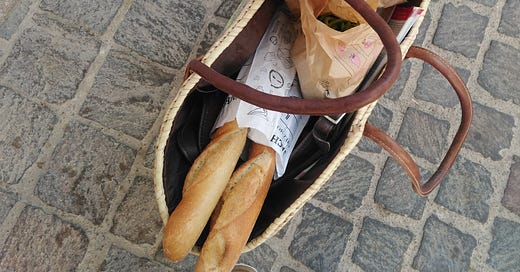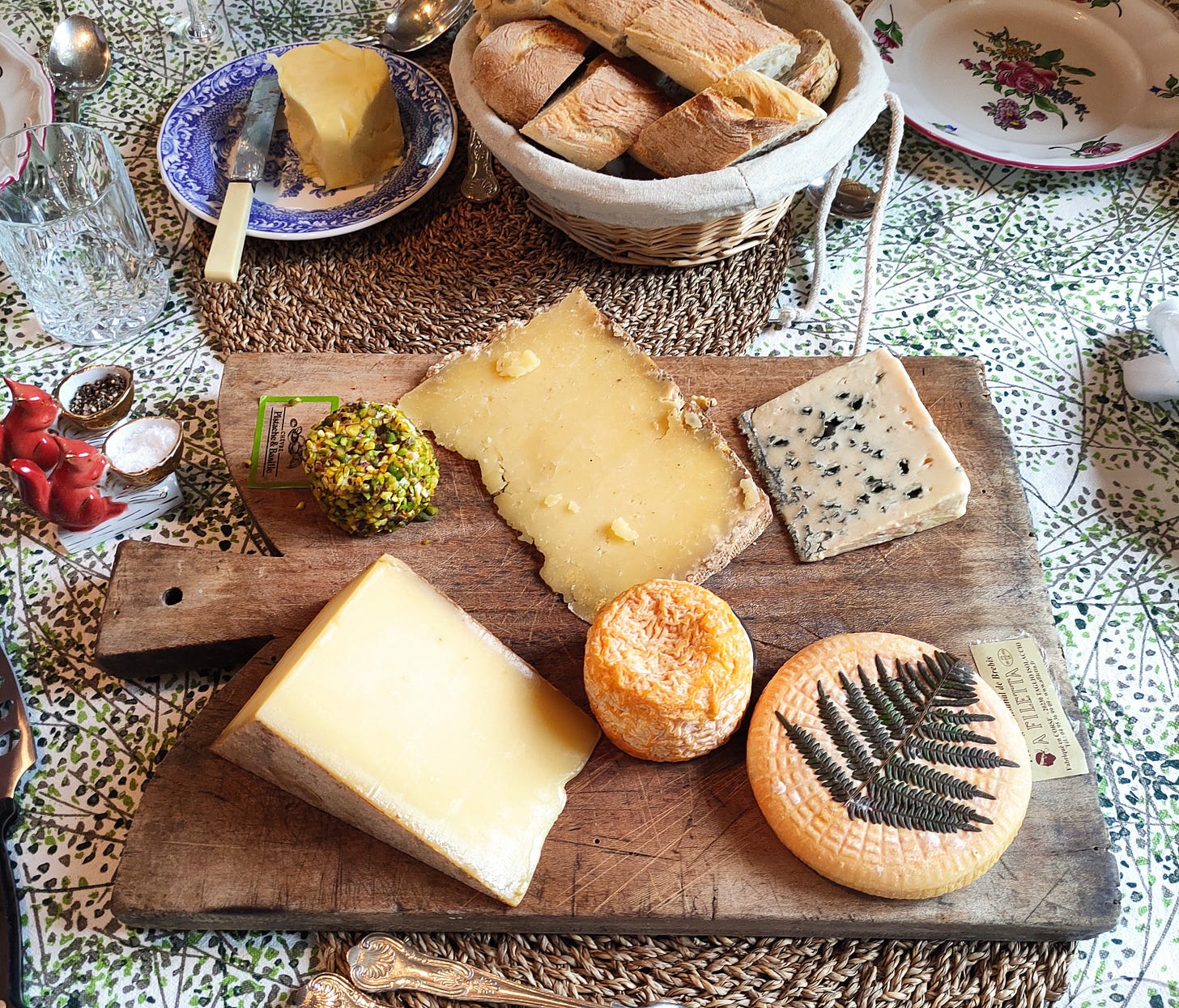Bread is heaven
This week, the great bread scandal that rocked the village, plus a favourite recipe for roast chicken.
A couple of summers ago, our first summer after we moved here, the most heated topic of conversation was not, well, the heat, nor the height of the new buildings by the lagoon, nor dogs lost on the road out of the village, stolen mopeds, vandalised car mirrors, or whether there were more mosquitos that year than last, though of course all of those were been keenly discussed, and they still are. What was really exercising everyone that summer was bread.
You’re never more than 100m from a baguette. But let fury be undimmed, that is obviously not the point.
Astonishingly, two of the bakeries in the village had closed for five days, at the same time, in the first week of the summer holidays. To hear some talk, you would think it was grounds for reintroducing the guillotine. (NB Just to get this out of the way, I promise not to mention Marie Antoinette or brioche in this piece. We all know that old tale, don’t we?)
The village discussion went back and forth: there must be a system of organising the times they’re closed, perhaps they mayor should intervene; well, it was all of you who wanted the 35 hour week; there is a great bakery on the way out of town, off the Avenue de la Belle Scribote; it’s too far for pensioners, what if you don’t have a car? What we need is a Marie Blanchère (a popular bakery chain), that’ll show them what’s what. And on and on.
The liveliness of this discussion was undimmed by the knowledge, certainly on the part of all of those taking part in it, that there are two other bakeries in the village, the Spar corner shop and a supermarket a short distance up the hill, that all also sell bread. The greengrocer’s on the church square is also a dépôt de pain. You’re never more than 100m from a baguette. But let fury be undimmed, that is obviously not the point.
A proper baguette should be made on the premises where it’s sold, and consist only of wheat flour, salt, water and yeast. By tradition, it should be 60-65cm long, 5-6cm wide, weigh about 250-300g, and be slashed five times with a knife to allow the carbon dioxide to escape during baking. It can’t be frozen at any stage or contain additives or preservative. This means they go stale very quickly. It is very possible that the real reason that French women don’t get fat is because they burn off all the calories consumed eating bread by walking to buy a baguette ten times a day to ensure freshness at all times.
This baguette obsession is also perhaps why the extrémité du pain, the crusty end of the loaf, a long-established reward – possibly, this being France, codified into law - for those who go to collect it, has many regional words to describe it. Where we live in the south west, it’s the crognon or the quignon, even further south on the Spanish border, it’s croustet. In the north, it’s the croûton, in the north east, the cul (which also means arse, sorry to disturb your jambon beurre), and in a small tranche of France on the border with Switzerland, it’s crotchon, which sounds like something you might catch in a terrible B&B.
Surprisingly perhaps, the baguette - the gustatory equivalent of Marianne as a symbol of France - is a relatively recent phenomenon. They may have been around for a while longer, but the first mention of a baguette as a loaf of bread dates only to the early Twentieth Century. In the 1830s, Austrian baker August Zang (also believed to have been the inventor of the croissant, may we shower his memory with delicious, buttery crumbs) installed France’s first steam oven in his Boulangerie Viennoise at 92, rue de Richelieu in Paris. This made it possible to bake loaves with a crisp crust and a light, airy centre, the first glimmers of the bread we enjoy today filled with cheese, pâté or ham, or spread with butter and jam and dipped into bowls of milky breakfast coffee.
But it wasn’t until March 1919 when a law was passed which forbade bakers from working after 10pm or before 4am. Larger, traditional loaves could not be mixed, proved and baked in time for breakfast, but our hero, the long, thin baguette could. In 1920, we see the first reference to a loaf of bread called a baguette. And lo, a star was born.
There is a hotly contested competition, sponsored by the Confédération Nationale de la Boulangerie et Boulangerie-Patisserie Française, for who makes the best traditional baguette in France. The loaves are judged on technique, texture, aroma and crumb. This year, the tenth annual contest was won by Zouhair Byadi, of the boulangerie-patisserie, Ferry in Meulan-en-Yvel. The competition is usually accompanied in the press by much muttering and hand wringing over the industrialisation of baking and the number of poor loaves there are out there, for they are legion, usually to be identified by their blunt, square end, not the fine rounded point which is the mark of the artisan. And then there are those who launch in with their preferences for the flûte, which is a thicker and heavier loaf, or the ficelle, which is thinner and lighter. Our best bakery also does a special loaf with a softer crust, hugely popular with those in possession of wobbly teeth. There is truly something for everyone.
But while the French are fussing over the baguette and what to call it, it seems they have forgotten to produce a decent industrial white load, of the sort that is essential to a bacon sandwich. This might also be related to the fact that they have forgotten to invent decent sliced bacon. Pain de mie, the standard sliced white found in many supermarkets, is a poor, flabby, over-sweetened thing, unworthy of bacon, unworthy even of a smear of ketchup or brown sauce, which would no doubt make it disintegrate into a flabby mess anyway. As a consequence of this, bought sandwiches are invariably an abomination (don’t drag me, it’s not all artisan, all the time, you know – sometimes life requires a hasty stop at a service station on the way to Ikea or the DIY shop).
It’s astonishing, given the consternation about a couple of bakers taking a holiday, that anyone puts up with it. Greying, tinned tuna, or flavourless chicken in cheap mayonnaise, a few wilting leaves thrown in as a nod to health, cling pathetically to the slices of bread as though in embarrassment. And they have plenty to be embarrassed about, these desperate efforts which make airline sandwiches look like a gourmet treat.
But soon enough, the bakers will be back and we can all find new things to moan about. Parking for tourists and lack of beaches where you can walk your dogs are quite enough to keep us going well into the autumn, if we really put our minds to it.
In the meantime, this weekend I was making lunch for new friends and in my usual fashion of when in doubt, ROAST A CHICKEN, I roasted a chicken. This time, I roasted it with lemon, tarragon and goat’s cheese. Though I say it myself, it was good, easy, quick to prepare, and even swifter to eat. It was great straight out of the oven, and the leftovers were wonderful in a salad the next day. I commend it to the group.
Poulet au citron, éstragon et fromage de chèvre
Roast chicken with lemon, tarragon and goat’s cheese
I wrote this recipe years ago for a feature in Sainsbury’s magazine and I’ve tweaked it quite a bit since. Hot or cold, it makes for a great summer main course.
You want to use a soft, rindless goat’s cheese for this and – though I’ve never done it – I bet at a pinch you could use that corner-shop favourite, Boursin. I like to serve the carved chicken on a bed of saffron rice, with the juices poured over and the roasted lemons on the side. But obviously, you can serve it however you want to serve it.
Serves 4-6
Keep reading with a 7-day free trial
Subscribe to Lickedspoon with Debora Robertson to keep reading this post and get 7 days of free access to the full post archives.






